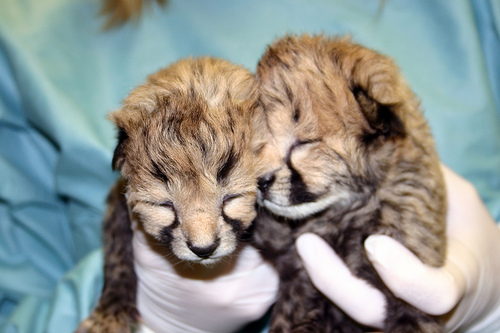Two Cheetah Cubs Transferred to the Smithsonian's National Zoo
Animal Care Staff Took Extraordinary Measures to Keep Cubs Alive
Three weeks after their unconventional and rocky entrance into the world, two 3-week-old cheetahs were transported May 18 to the Smithsonian's National Zoo in good health, thanks to the hard work and swift actions of animal care staff at the Smithsonian Conservation Biology Institute in Front Royal, Va. They are being hand-raised at the Zoo and will require around-the-clock care until they are ready to make their public debut late this summer.
Five-year-old cheetah and first-time mom Ally gave birth to the first cub, a male, April 23. However, instead of nursing and cleaning the cub, she abandoned him, which is relatively common for first-time mothers under human care. Cheetah keepers moved the cub to the veterinary hospital to be treated for severe hypothermia. When Ally suddenly stopped having contractions hours later, SCBI head vet Dr. Copper Aitken-Palmer anesthetized her to see if she had additional cubs. Aitken-Palmer heard additional heartbeats and performed a radiograph to determine that three cubs remained. She performed a cesarean section, a procedure rarely used on cheetahs and one that cubs do not often survive. A team of veterinarians, keepers and scientists worked for three hours to resuscitate the three cubs, performing CPR, administrating medications and rubbing the cubs to dry and warm them. One of the three cubs, a female, did survive.
Given how rare this procedure is, we thought it'd be unlikely for any of the cubs to survive, said Adrienne Crosier, SCBI cheetah biologist. But that little female is a fighter. Once we got her breathing, she just kept going. It was a very intense, stressful experience, but among the most inspiring of my career.
Both cubs and their mother were in intensive care for the following three days. The cubs' father, Caprivi, was brought to the veterinary hospital to donate plasma to the cubs to boost their immune systems. Today both cubs and their mother appear to be in good health, though animal care staff is continuing to monitor all three carefully.
There are now two new genetically valuable cubs in a population that so desperately needs them, Aitken-Palmer said. So this is really a success for this struggling species.
Because Ally rejected the first cub, animal care staff is hand raising both cubs, which requires bottle feeding every few hours. Having two hand-raised cubs presented a unique opportunity to bring the animals to the Zoo, according to Tony Barthel, curator of the Zoo's Cheetah Conservation Station, where the new cubs will live. In addition to the four litters born at SCBI in Front Royal, two litters of cheetahs have been born at the Zoo's Washington facility since 2004.
Moving mom and cubs is more challenging than moving the cubs alone for many reasons, Barthel said. The cubs will continue to need care and we're not out of the woods yet. The goal is to ensure that the cheetahs thrive and become ambassadors for their species.
Ally and Caprivi were paired as a recommendation of the Association of Zoos and Aquariums' Species Survival Plan for cheetahs. The SSP matches animals across the country to ensure genetic diversity in the population. The mortality rate for cheetah cubs in human care born under normal circumstances is 20 percent during the first six months, compared to a mortality rate of up to 70 percent in the wild population in east Africa. SCBI is one of five centers participating in research to boost the captive cheetah population as part of the Conservation Centers for Species Survival, also known as C2S2. In addition to four litters born at SCBI in Front Royal, two litters of cheetahs have been born at the Zoo's Washington facility since 2004.
Cheetahs, the fastest animals on land, are struggling to outpace threats to their survival in the wild. As the result of human conflict, hunting and habitat loss, there are only an estimated 7,500 to 10,000 cheetahs left in the wild. The International Union for Conservation of Nature considers cheetahs a vulnerable species.
The Smithsonian Conservation Biology Institute plays a key role in the Smithsonian's global efforts to understand and conserve species and train future generations of conservationists. Headquartered in Front Royal, Va., SCBI facilitates and promotes research programs based at Front Royal, the National Zoo in Washington, D.C., and at field research stations and training sites worldwide.
# # #

